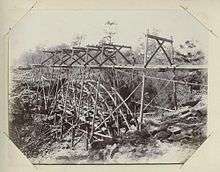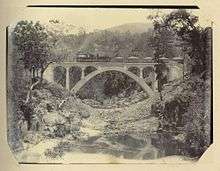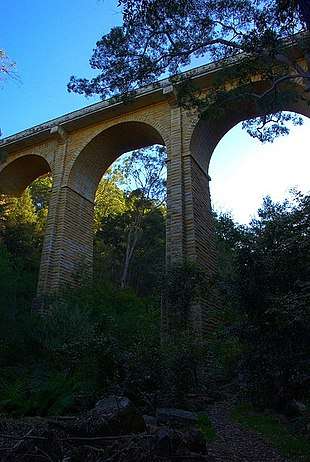Deep Creek Railway Bridge
Deep Creek Railway Bridge is a heritage-listed railway bridge on the Mungar-Monto railway line in Didcot, North Burnett Region, Queensland, Australia. It was designed by William Pagan and built in 1905 by day labour. It was added to the Queensland Heritage Register on 21 October 1992.[1]
| Deep Creek Railway Bridge | |
|---|---|
_Bridge_(1994).jpg) Deep Creek Railway Bridge, 1994 | |
| Location | Mungar-Monto railway line, Didcot, North Burnett Region, Queensland, Australia |
| Coordinates | 25.4666°S 151.9418°E |
| Design period | 1900 - 1914 (early 20th century) |
| Built | 1905 |
| Architect | William Pagan |
| Official name: Deep Creek Railway Bridge, Chowey | |
| Type | state heritage (built) |
| Designated | 21 October 1992 |
| Reference no. | 600031 |
| Significant period | 1900s (fabric) |
| Significant components | abutments - railway bridge |
| Builders | Day labour |
 Location of Deep Creek Railway Bridge in Queensland  Deep Creek Railway Bridge (Australia) | |
History

The Mungar-Monto railway line was built only as far as Degilbo before the financial depression of the early 1890s halted the rail construction program. Construction resumed in 1905 under the Railway Department's day labour program. William Pagan was Chief Engineer at the time. Construction began on the Degilbo to Wetheron extension in February 1905. William Pagan inspected the extent of the construction and preparatory work on the Deep Creek bridge in March 1905. The bridge was completed and the line opened by 21 December 1905. Pagan described the bridge in his annual report for that year as "a concrete bridge of somewhat novel design".[1]
The bridge represented a substantial development in concrete arch bridge design. It followed the 33-foot (10 m) spans used in Swansons Rail Bridge on the Main Line near Toowoomba and the 47-foot (14 m) span at Petrie Terrace road overbridge. It was followed by two substantial concrete arch bridges on the Main Line near Lockyer.[1]
Description

Deep Creek bridge is a concrete viaduct with an 80-foot (24 m) concrete arch flanked by two smaller 15-foot (4.6 m) arches, with the track run on sleepers and ballast in a trough. It has the date of construction, 1905, cast into the sides.[1]
It consists of:[1]
- Embankment
- 1 x 15-foot (4.6 m) concrete arch, ballasted top, concrete abutment, common concrete abutment.
- 1 x 80-foot (24 m) concrete arch with 4 x 15-foot (4.6 m)spandrel arches, ballasted top, common concrete abutments
- 1 x 15-foot (4.6 m) concrete arch, ballasted top, concrete abutments, common concrete abutment.
Heritage listing
Deep Creek Railway Bridge was listed on the Queensland Heritage Register on 21 October 1992 having satisfied the following criteria.[1]
The place is important in demonstrating the evolution or pattern of Queensland's history.
This concrete arch bridge has the third longest span of its type in Queensland and was the third bridge of its type to be constructed in Australia. The bridge frames the rocky valley of the creek and its innovative design was associated with the Chief Engineer, William Pagan.[1]
The place demonstrates rare, uncommon or endangered aspects of Queensland's cultural heritage.
This concrete arch bridge has the third longest span of its type in Queensland and was the third bridge of its type to be constructed in Australia.[1]
The place is important in demonstrating a high degree of creative or technical achievement at a particular period.
The bridge frames the rocky valley of the creek and its innovative design was associated with the Chief Engineer, William Pagan.[1]
The place has a special association with the life or work of a particular person, group or organisation of importance in Queensland's history.
The bridge frames the rocky valley of the creek and its innovative design was associated with the Chief Engineer, William Pagan.[1]
References
- "Deep Creek Railway Bridge, Chowey (entry 600031)". Queensland Heritage Register. Queensland Heritage Council. Retrieved 1 August 2014.
Attribution
![]()
External links
![]()
